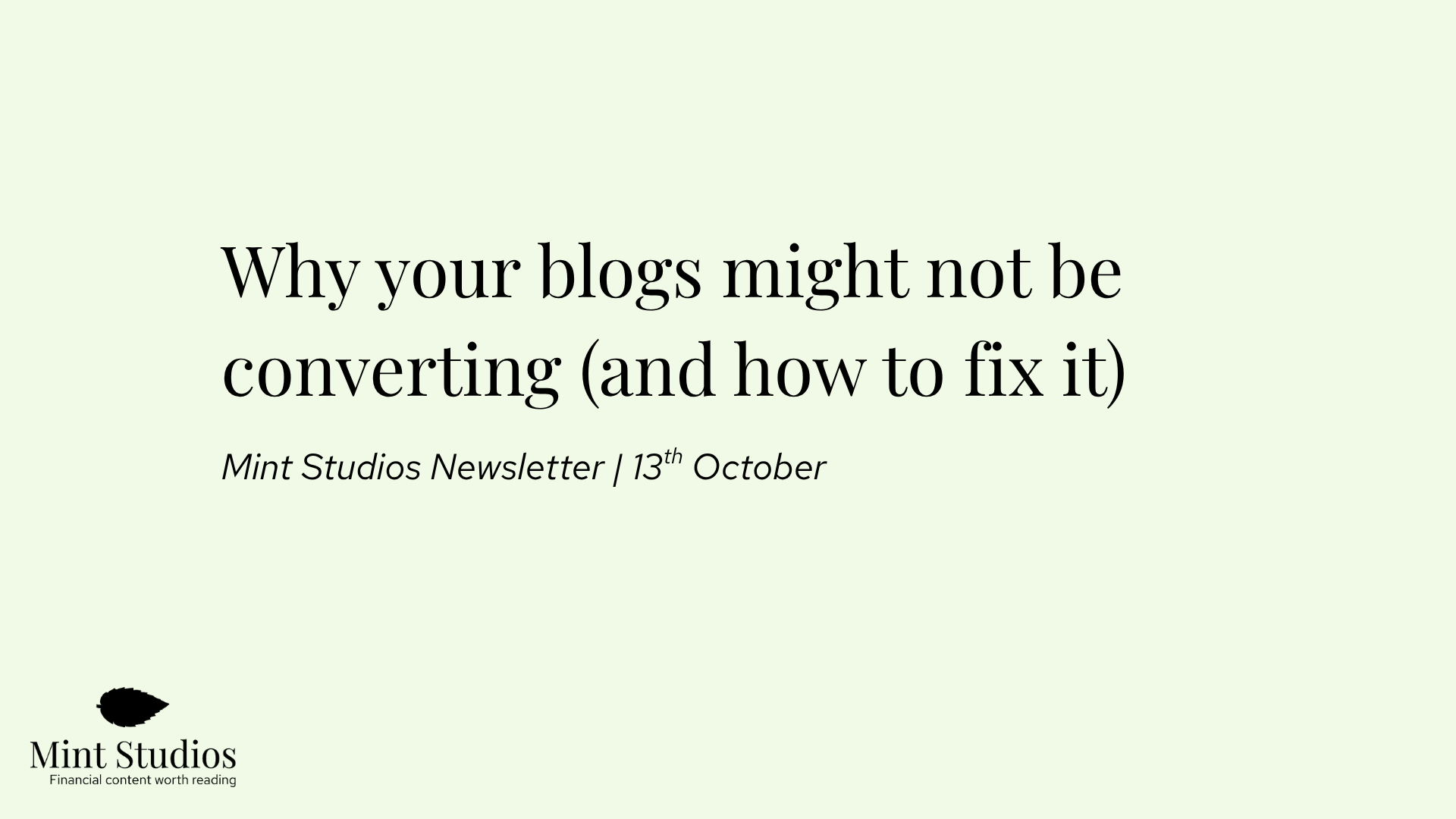In this article, we cover six fintech brands that are doing content marketing that actually works - consider these as case studies to inspire your own strategy.
We’re not just talking about nicely written content with fun graphics that bring in just traffic, we’re talking about content that actually generates potential customers (or in one case, employees).
No, we don’t have access to the internal metrics of each company — but based on podcast interviews with their Heads of Marketing and our own experience running a content marketing agency in the fintech industry, we can tell what type of content brings in results.
Before we get started, what is our definition for “content marketing”?
In this case, we will use the content marketing definition which aligns with the work we do for clients: creating long form content that is published on the website. These are usually articles that range from 1,000 to 5,000 words, are written for a specific business purpose and are published on a website.
Note: are you a fintech startup looking for support with content? We’re a content marketing agency that helps fintech companies turn their blog into a customer acquisition channel. Learn more about what we do.
Let’s get started:
1. Wise: content that talks about competitors
Wise is a money transfer app and platform in the fintech space, usually used to send money abroad at low cost.
Although Wise has immense resources and a robust marketing team to implement a fintech content marketing strategy correctly, we wanted to point out a specific strategy they use that can be replicated by anyone: creating articles that break down how to open and close an account with their competitors. Here are some of the titles of the articles:
- How to close your ING Australia Bank account
- How to close your UBank account
- How to open a bank account with Westpac
- St. George Bank international transfer: Fees, rates and transfer time
A traditional marketer might first think this is crazy: they’re giving the spotlight to competitors! But a content marketer can see further.
First of all, someone who is typing “how to close a UBank account” is likely to be someone who’s ready to start using Wise: they’re maybe changing bank accounts and are looking for other options. That’s someone who’s ready to convert and is at the Bottom of the Funnel.
Second of all, by writing an article that answers the readers intent, Wise is owning the narrative. Wise gets to include their own product in the article (without being overly salesy and spammy). When someone is searching for how to open an account with Westpac, they are reading on Wise’s website. That’s a lot better for Wise, isn’t it?
It’s a very clever content marketing strategy, and one we do for clients at Mint Studios as well. We can say with reasonable confidence that these types of articles are generating a decent amount of customers for Wise.
2. Curvo: creating content before launching the product
Curvo is an investment app for millennials based in Belgium. They are totally bootstrapped, and have been doing content marketing from day 1. They’re two founders, and they’ve been creating articles consistently (along with videos, social media and more) all themselves.
After two years of building, they launched the product. Within a week, they had 14 customers. Now, several months later, they have over 300. On our podcast episode with Thomas, co-founder of Curvo, says that all the initial sign ups were from Google’s search engine/content marketing, validating their early marketing efforts.
Their strategy? Start with content right from the beginning, and prioritise it to establish themselves as a thought leader in the investment space for millennials. They’re not publishing content like “10 ways to save money” and “tips to be frugal”. It’s genuinely informative, well formatted and written high-quality content. As a team of two, they’ve managed to get to 5,000+ pageviews per month, and they are ranking for super important keywords like:
- ETF Belgium
- Portfolio visualiser
Head over to their blog and you’ll see what we mean: Curvo Academy
3. Argyle: content that answers customers’ questions
Argyle is a B2B financial technology company that provides a single global access point to employment data. They provide the worker with a single overview of all their employment history and therefore allow businesses to examine a worker based on multiple income sources.
You’ll find a lot of B2B fintech companies with content like “Top 10 ways to improve your payment processing”. In the fintech marketing Slack group we were talking about how a lot of B2B content seems to be full of fluff.
However, Argyle is a company that does a great job with content creation. If you head to their blog, you’ll find advanced content for an advanced audience.
From our conversation with their Head of Marketing, Eva Sasson, Argyle creates content based on conversations with their customers. Every month, they do a brainstorming session and come up with content ideas and create content that focuses on problems people are facing.
If your company is a sales-heavy B2B, it’s often best to start by creating financial content that answers the most frequent questions and the pain points of your customers. As long as the content is well written and useful, that is often enough.
In this piece of content by Sean Blanda, he makes the case that sales-heavy SaaS companies should start with email, rather than SEO. Although Argyle is not SaaS, it is definitely sales-heavy. Creating content that answers your most common customer questions is a good place to start with content marketing.

Some examples of the content Argyle creates:
- Streamline Your Workflow with OCR from Argyle
- Ensuring Accurate Underwriting for Gig Workers
- Webhooks Explained: Smarter, Faster, Cleaner Data with Argyle
Although we’re not sure what results their content brings in, Eva did say that content is an important part of their marketing mix, and that customers regularly mention having read some of their pieces.
4. Moov: content that helps with hiring
Moov is a company that helps developers accept, store and disburse money. They’re a platform built by developers for developers, with a focus on delivering exceptional user experiences.
We don’t have insight into their blog on the customer acquisition side, but we do know that content marketing has played an important role in hiring.
On our podcast with Bryan, Head of Marketing at Moov, he said that the articles on their blog titled “Why I joined Moov” played a big role in hiring. As in, new employees regularly referenced these articles when explaining their motivation to join Moov.
Content marketing doesn’t have to be just for customer acquisition; it can also play a large part in recruiting. Asking new members of your team to write an article on why they joined your company could help a lot when it comes to hiring.
It’s an interesting strategy, and a very cool one. Here are examples of two of the articles:
5. Spendesk: comparison posts that rank for high intent keywords
Spendesk is an all in one spend management platform built for finance teams.
Their content always turns up when I’m trying to rank for a specific keyword — usually Bottom of the Funnel. That’s because they have a very intentional SEO strategy with thorough keyword research and are ranking for all the right keywords.
Here are some of the keywords they are ranking for:
- Spend management providers
- Here’s the article: 10 top spend management software solutions for 2025
- Business travel solutions
- Business travel solution
As you’ll see, Spendesk is targeting these keywords with blog articles, not landing pages. This aligns with our experience that blog articles usually do better than landing pages when it comes to ranking and converting readers.
Spendesk is ranking for great tool keywords and product keywords, which are very high intent keywords — meaning, people searching them up are usually ready to convert and become customers. By creating a comprehensive article that targets that keyword and then putting your solution at the top, you’re capturing high quality leads.
We can guess that a large part of their organic conversions come from these types of articles. It’s also very interesting to see how they don’t mention their direct competitors (Pleo, Payhawk, Soldo) in any of the pieces.
The one thing we would change would be to add a Call to Action button right after the introduction. The keywords they are ranking for are such high intent, that some people clicking might want to just sign up immediately without reading anything. By adding a CTA right after the first few lines, you can make sure you capture those people.
We’ve done this with one of our clients, Parpera. Note how this article targets a “tool” keyword and also includes a CTA at the beginning: 5 Project Management Tools for Freelancers (in Australia)
6. Pensionbee: influencer marketing via content
Pensionbee is a B2C fintech company that helps people save and manage their pensions. Their overall content is great, but what’s worth talking about is their influencer marketing strategy.
When their product first launched, they decided to partner with personal finance bloggers to help promote their product. 5 years later, they are still partners with these same bloggers that have also grown with them.
Lynn Beattie is a well known UK personal finance blogger, and she runs the Mrs Mummy Penny blog. If you scroll through the Pensionbee blog, you’ll find blog articles written by her that date back to March 2017 — just 1 year after the Pensionbee product was live.
You’ll also find other bloggers have written guest posts for them on the blog. These guest posts exchanges probably helped Pensionbee at the beginning and has also helped them gain over 10,000 backlinks 5 years later.

Some examples of the articles written by influencers include:
- What does the average pension look like for women over 50?
- 9 free things to do in the summer holidays | PensionBee
Influencer marketing is a powerful way to gain traction when your product is new or you don’t have much of an audience. Although it’s hard to say how many conversions Mrs Mummy Penny brought in, there is no denying it helped with brand awareness and her sponsored articles will have also generated conversions.
Although the content marketing space is getting increasingly competitive, it doesn’t mean that everyone is doing a good job. In fact, we would argue that most content on Google is still pretty bad and not generating real results for businesses. These six fintech companies, however, are doing a great job — and there is still opportunity for more fintech startups to create great content that brings in results.
Our approach to creating fintech content that brings in customers
It’s hard to tell if a company is doing a good job with their fintech content without knowing the internal metrics, like pageviews, conversions, rankings and what their priorities are at the moment. Which is why the examples above are not 100%: we only know what we see from the outside.
If you’re trying to understand whether your own content is doing a good job, then you need to evaluate this yourself based on overall company objectives, marketing objectives, and where your content is right now (and if you want to hear our opinion, you’re welcome to reach out).
We specialise in helping fintech companies use content for customer acquisition. But not all fintech companies are focused on customer acquisition – some may prefer to use content for brand awareness or purely educational processes.
If you’re interested in reading about how to get customers with content, then keep reading.
First of all, when fintech companies come to us wanting help with customer acquisition via content, there are a few mistakes that we see marketers make time and time again:
- They often don’t have a systematic approach to coming up with content ideas, and the strategy is based on brainstorming and guesses. That’s how you end up with content that your target market doesn’t read and that doesn’t help you reach your targets.
- They write content for everyone, rather than their ideal customer.
- They work with writers who don’t specialise in fintech and therefore can’t write technical or advanced content.
- They don’t track sales-related metrics, making it very hard to know what’s working and what isn’t.
You can read more about the common mistakes we’ve seen here: The Content Tower of Pisa: Why Fintech Content Programmes Fail
These common mistakes leads to a situation where your fintech content:
- Brings in high traffic, but no sales.
- Isn’t being read by your ideal customer.
- Costs money, but doesn’t bring in customers.
We’ve helped 20+ fintech companies implement a content strategy that brings in customers, and not just organic traffic.
We’ve helped some companies use their blog to bring in six figure customers, to get customers more cost-effectively than via ads and to rank for 10+ buying-intent keyphrases.
Here’s how we do it:
- Content strategy based on customer research and focused on Bottom of the Funnel
As we mentioned above, the number one mistake when it comes to creating content for acquisition is marketers don’t spend enough time understanding who their ideal customer is.
That’s why we spend the first month working with a fintech company interviewing key people on the team to understand who the customer is, their audience needs and their pain points.
We try to identify two things:
- Understand who your best customers are.
- Understand what their pain points and challenges are.
Based on those conversations, it’s a lot easier to put together a strategy.
Read more here: How to Do Research for Bottom of the Funnel Content Marketing
Secondly, we almost always start by targeting prospects who are at the bottom of the marketing funnel. Most marketers who are focused on customer acquisition will start by targeting those at the top of the funnel. This leads to publishing beginner type content that will be never read by your target customer. It could take years before you see conversions from top of the funnel content.
We believe it makes more sense to start at the bottom. By targeting those people who already know what the problem is and are actively looking for the solution.

We published different types of content for a client of ours, and you can clearly see below that BOFU content converts at a much higher rate than TOFU. So if your focus is on customer acquisition, then it makes more sense to start with BOFU content.

Here are examples of BOFU content. Notice how they’re targeting people who are ready to take action:
- Direct Debit API: How to set one up (and when to use one)
- API for bank transactions: how to pick the right one
2. Content for the level of your reader and focused on your product
A lot of fintech companies create content that is written for beginners.
This won’t work if you’re trying to acquire customers and your decision maker or influencer is an expert in their field. If you’re targeting Heads of Payments or CTOs, they won’t read something titled “what is a direct debit”. They’re more likely to read “direct debit API”.
Even if the topic is correct, you still need to write for the same level of knowledge as your ideal customer, which is essential for building trust with your audience. If not, your ideal reader will simply click away and never read your content.
And that’s how you end up creating a lot of content your target audience doesn’t read and doesn’t bring in results.
That’s why when we create content, we aim to write advanced content for an advanced audience. We use an in-depth process with our writers to ensure the writer understands the customer pain points and can write for them.
Learn more about our process here: How to hire a content writer
3. Content based on interviews with experts
A lot of content out there is copycat content. It’s based solely on desk research, which leads to regurgitated content that doesn’t position you as an expert and doesn’t add anything to the discussion.
To avoid this, 90% of our content is based on interviews with internal experts. With this approach, we can ensure our content is unique, has an expert point of view and is written at the level of our target audience. Again, when you’re writing for experts, content based on expertise is a lot more likely to capture their attention and take you seriously than beginner style content.
By creating educational content based on interview, we’re also able to:
- Go into more depth about our client’s product.
- Add screenshots of the product itself.
- Include information that only Subject Matter Experts would be able to share.
Learn more about our methodology here: Why You Should Create Content Based on Interviews With Experts
4. Content results that can be tracked
Finally, if you’re focused on customer acquisition, you need to be tracking sales-related metrics. If not, you won’t know if your strategy is working.
Most marketers believe that attribution is impossible with content. But this isn’t true: with a combination of Hubspot and Google Analytics, we can track who signed up after reading a blog post. With Hubspot, we can even attribute this to a specific contact name and deal size. See how we’re able to track this with one of our clients:

By tracking the right metrics, we’re able to tell our clients how much new business content brings in. As a marketer, that allows you to make a business case for a larger marketing investment that aligns with broader business goals, or to keep investing in content.
Read more here: How Many Leads Can You Generate with Content Marketing?
We hope this article was useful and give you some ideas for your content marketing. If you’re looking to increase lead generation and customer acquisition with your content, then make sure you’re avoid these mistakes and start with the Bottom of the Funnel. If you’d like to have a discussion with us, reach out via the button below.











